Hatchery Rearing: Natural Selection Vs. Fecundity Selection
Posted 2016-04-11 17:36:43
| Views: 1,378
Hatchery Rearing: Natural Selection Vs. Fecundity Selection
One Chinook Salmon’s Point of View
As a femifish—who, mind you, has not once felt in need of any bicycle—I find myself personally involved with the captive breeding debate. I have al-ways been a proponent of great minds like Globefish Steinem and Bell Fishhooks; I have always supported the idea that a fishes body is hers, and that she alone should possess control over it. Contrary to popular opinion, I have never doubted that I do, in fact, have a backbone. But with age comes wisdom, as well as a deeper responsibility towards my own school of fish—a broader purpose, perhaps. It is here that I am catapulted into deciphering the semantics of my own own personal dilemma on the subject of hatchery rearing.
Humans, sure. They think captive breeding programs are great. They “love” salmon. Grilled, seared, baked, breaded—you name it. Ten years ago when sushi really started to take off, did you hear me complain? This hatchery rearing, however, is a different story. Humans really think that these programs increase the Chinook preservation—and honestly, with that I can get down (for a fish who swims upstream). Scientists are using these programs to supplement populations that are declining, and to help our little fry grow up into strong anadromous fish with tons of Omega-3s. However, we need to figure out a middle ground, on which scientists can help us maintain our population sizes, without discouraging maladaptive traits.
You see, the genetic implications are what worry me about captive breeding programs. Not only are our eggs being taken from us involuntarily, but this is actually starting to throw off the equilibrium of our unique Chi-nook traits. Scientists are conducting studies about how fecundity selection is promoting unnaturally small salmon eggs, when in the wild, natural selec-tion favors large eggs. The “catch” is that unintentional selection in captivity can lead to rapid-changes in our critical life-history traits, thus reducing the success of reintroducing such salmon back into nature.
As a femifish—who, mind you, has not once felt in need of any bicycle—I find myself personally involved with the captive breeding debate. I have always been a proponent of great minds like Globefish Steinem and Bell Fishhooks; I have always supported the idea that a fishes body is hers, and that she alone should possess control over it. Contrary to popular opinion, I have never doubted that I do, in fact, have a backbone. But with age comes wisdom, as well as a deeper responsibility towards one's own school of fish—a broader purpose, perhaps.
It is here that I am forced to decipher the semantics of my own own personal dilemma on the subject of hatchery rearing.
Humans, sure. They think captive breeding programs are great. They “love” salmon. Grilled, seared, baked, breaded—you name it. Ten years ago when sushi really started to take off, did you hear me complain? Never. This hatchery rearing thing is a different story. Humans really think that these programs increase the preservation of my species—and honestly, I can get down with that (for a fish who swims upstream).
OP-ED ON Hatchery Rearing: Natural Selection Vs. Fecundity Selection
One Chinook Salmon's Point of View
But the common misunderstanding is that these reintroduction programs do only good. It's true that scientists are using these programs to supplement declining populations, and to help our little fry grow up into strong anadromous fish with tons of Omega-3s. However, we need to figure out a middle ground, on which scientists can help us maintain our population sizes, without encouraging maladaptive traits.
(Traits that become more harmful than helpful; in other words, the stark opposite of adaptations that we have spent hundreds of thousands of years acquiring)!
You see, the genetic implications are what worry me about captive breeding programs. Not only are our eggs being taken from us involuntarily, but this is actually starting to throw off the equilibrium of our unique Chinook traits. Scientists are conducting studies about how fecundity selection is promoting unnaturally small salmon eggs, when in
By Simone de Salmon
the wild, natural selection favors larger eggs.
[Fecundity selection is the process by which differential reproductive success among individuals in a population is the result of phenotypic traits that contribute to the production of a higher number of offspring per reproductive episode. The theory was coined by the human Charles Darwin in 1869.]
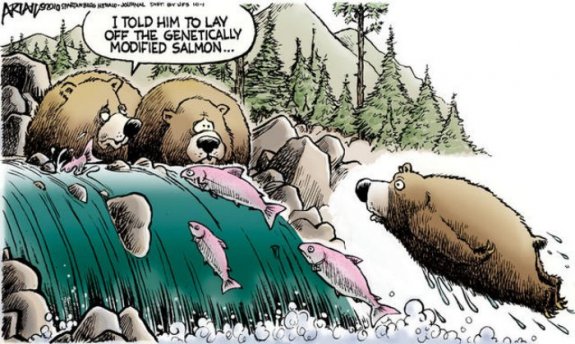
Heath, Daniel D. “Rapid Evolution of Egg Size in Captive Salmon.” Science Magazine. (March 2003): 1738-40. University of Windsor. Web. 11 April 2016.
Hooty Help
with your favorite owl
Harriet
Dear Harriet,
Lately, it's been pretty tough in here at the bird sanctuary. My mates are all closely related to me, and our numbers have been sparse. How can I keep our population alive and have there be some better mates for the next generations? (My cousin Rudy just isn't going to cut it for much longer! He can hardly see well enough to break up the seed that our zookeepers give us). Please tell me what I can do to pick a better mate and keep the red Bishop line aloft!
Bliss, the southern red Bishop
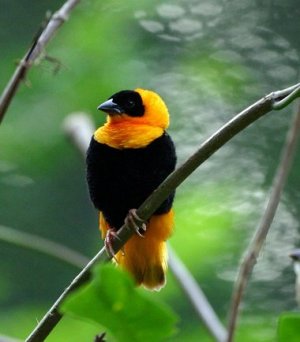
Dear Harriet,
I feel like my home hasn't been that great lately. Every time I walk about, my feathers drag so far against the ground and I feel like nobody watches my dance even though I try so hard to practice it. I feel like if I were just released into the wild things would be much better for me. You've gotta help, Harriet!
Perry, the Peacock
Dear Harriet,
I'm a special kind of dove, and my relatives were the ones who have always been the stars in movies (namely, the ones from Mary Poppins). Well, I haven't been quite as much of a star lately and I'm really worried that there isn't much unique about me anymore. My Australian accent sounds just like my British one, and my wife thinks that when we end up travelling away from the zoo for work that we are going to get really stressed out. Subsequently, she isn't that interested in having my babies because she thinks they'll be afraid and won't know how to adjust either. Is she just going coo-coo?
Danny, the dove
Bliss,
Well, as you know, I've spent many years in a sanctuary and have been taught a lot about captivity and variation by my zookeeper and researcher, Robert C. Lacy. Your keeper probably knows that you're being kept with other small and often endangered birds. With careful management, these populations can be kept from further decreasing in size. Lacy says “an immediate effect of the depletion of genetic variability is increasing homozygosity of the individuals in the population” and this leads to lower viability of your offspring.
Did you know that lots of humans have the misconception that animals in captive populations are safe from extinction? Well, this isn't necessarily true because of the lack of genetic variation in many captive populations. Make sure you're choosing the mates who build the best nests, those ones will help you produce more viable offspring. Best of luck to you, deary!
-Harriet
Perry,
Times are tough for the caged bird that dances. Although, I'm not so sure if I were you that I would be flapping at the chance to get out of your safe habitat. It's a rough world out there and if you and your species do not adapt to the environment when you are released, you'll be “susceptible to new predators, diseases, parasites, climatic condition, competitors, and changing food supply." Have there been any new immigrating peacocks to your area? If so, there might be a higher chance of new birds watching your dance and as my zookeeper says, " genetic variants introduced into a population by immigration act to restore alleles that formerly existed in the population." So for right now, I'd hang tight and make sure that you keep up your dancing, the right lady will come along soon. Keep me updated!
-Harriet
Danny,
Captive populations, like us, may lose “evolutionary flexibility” fairly quickly. This means that zoos must find a way to diminish the rapid lack of genetic variability in populations. Hoo, there seems to be a bit of a trend in the worries of our captive friends this week!
Well, the loss of our evolutionary flexibility is quite troubling. On the bright side, mutation won't be much of a problem for us. Oh, but now that I think about it this is one less thing driving our evolutionary force as birds!The idea of evolutionary flexibility was figured out by my zookeeper, who did a series of computer simulation tests that randomly bred small populations of individuals in order to figure out the amount of heterozygosity in a group. I can say your wife definitely has something to her fears. Make sure that your wife isn't actually your bird sister, that might help your babies be more successful. Hope to see you all in an upcoming flick!
-Harriet
All quotes from :
Lacy, Robert C. “Loss of Genetic Diversity from Managed Populations: Interacting Effects of
Drift, Mutation, Immigration, Selection, and Population Subdivision.” Department of
Conservation Biology 1.2 (1987): 143-158. 15 March 2016.
INTRODUCING A08: WILL HE SURVIVE?
***
A08, a young, male otter has no easy job—he has been reintroduced to a population of otters in an attempt to restore a flagship species, the Eurasian otter, that previously went extinct in 1998. He has been living in his new home in the Netherlands for over a year now and we’re here to catch up with his and see how his new home is treating him.
C: So, I heard that your transition into the new population was pretty rough, is that true?
AO8: Yeah, to be honest, at first, it wasn’t easy. I think people assume you can just plop one otter into a new population of otters and it will be all butterflies and rainbows. That was definitely not my experience--I was chased away by all the dominant males and they would hide food from me and none of the females would interact with me. Honestly, I thought I was gonna die and I had no chance of reproducing.
C: So what changed?
A08: Well, A18 died, and he was the alpha male around here so that winter, after his death, I reproduced with over 7 females. That was pretty cool to be honest. But the conservationists were worried because I was the male who was getting the most action, you know?
C: Why we're they worried about you reproducing?
What is a flagship species?
Popular, charismatic species that serve as symbols and rallying points to stimulate conservation awareness and activism
***
A08: So they were worried because they thought my offspring would mate with each other (the conservationists call this inbreeding--when two individuals mate who are closely related). Basically, if my kids mate with each other, well, it would be all bad. The conservationists don't really know what could happen exactly, because they told me: "Whether inbreeding will have an effect on the current population is yet unknown, since no data are available on the occurrence of inbreeding depression in otters" (Koelewijn et all., 2010) But basically, I think they're worried that if my offspring mated with each other they would be more likely to produce infertile offspring which would make it harder for them to survive and pass on their genes. They explained it to me in order to deter me from mating with so many of the females. Basically, they explained that my offspring are more likely to share similar alleles (versions of genes) with one another than they are with unrelated individuals.
C: Can you say more about this?
A08: So, if one of my daughters and one of my sons both have the same recessive allele then they'll pass those two recessive alleles onto their children, which would be called a homozygous gene and if the alleles are deleterious or harmful, then they can cause disorders. Basically, there isn't as much genetic diversity if the individuals are closely related (Lorimer). Having a bunch of sick or infertile otters would sort of defeat the whole purpose of this whole reintroduction thing, you know? Also, they were worried cause if I’m dominating the reproductive process then it doesn’t really increase the population size, you know?
C: So it sounds like things are pretty rough right now?
A08: Yeah, it has been kinda rough but it’s nice having a lot of friends, you know? But a lot of my friends are being killed in traffic incidents. We’re just tryna explore, you know? But a lot of dudes have been dying from traffic accidents, most of the females are okay though. But it’s the highest cause of mortality right now (Koelewijn et all., 2010).
C: I heard rumors they’re trying to find another population for you all to mate with?
A08: Yeah, I heard that too. They said ideally they would find another population for us to breed with to counteract the possible negative effects of inbreeding… but I also heard if they can’t do that then they’re gonna reintroduce an unrelated male (like they did with me last year) so, we might have some new competition around here…
C: Well, I wish you the best of luck and hope you stay safe!
A08: Hey, thanks man! Catch up with ya later!
***
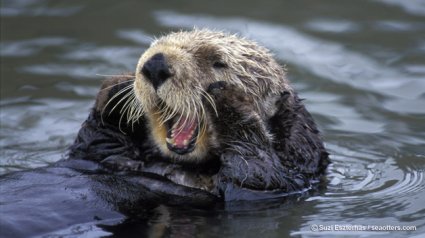
Portrait of A08
Sources:
Morell, Virginia. “Into the Wild: Reintroduced Animals Face Daunting Odds”. Science 320.5877
(2008): 742–743. Web.15 March 2016.
Koelewijn, H. P., M. Pérez-Haro, H. A. H. Jansman, M.C. Boerwinkel, J. Bovenschen, D.R. Lammertsma, F.J.J. Niewold, and A.T. Kuiters. "The Reintroduction of the Eurasian Otter (Lutra Lutra) into the Netherlands: Hidden Life Revealed by Noninvasive Genetic Monitoring." Conservation Genetics Apr. 2010: 601-14. Springer.com. Springer Netherlands. Web. 01 May 2015.
Lorimer, Heather E. "Inbreeding and Genetics." Inbreeding and Genetics. N.p., n.d. Web. 02 May 2016.
A Fishy affair
Olive Otter
As any otter will tell you, steelhead trout are first and foremost dinner. They are not the sort of creatures you invite to an evening party at your river home but instead serve to your guests. Yet, since the humans started poking around Hood River, even an otter like me started to wonder about the state of the steelhead fish. New steelheads, still so young they wouldn't make a tasty snack, would suddenly appear in the river while older fish would disappear never to return again. Many of the new young fish don't last very long, and are an easy target for even the most unskilled, portly, otter. Around the time such occurences would happen, witnesses described seeing humans clothed in white lab coats muttering frantically about accelerated adaptation to captivity and accidentally selecting for certain traits. A rather knowledgable frog has since informed me that accelerated adaptation is when a population is adapting to an environment very quickly, sometimes in only a few generations. This amphibian informer also reminded me that certain traits are favorable to survival, and such helpful traits tend to get passed on, or selected for. This selection of traits can take place in the wild or even in a mad scientist's laboratory.
Then, one of these strange humans, who called himself Mark R. Christie, left behind some crumpled papers, found by a rather nosy sea gull I won't name. This discovery made things a little clearer for us river creatures. The papers, which humans sometimes call an article, were titled "Genetic Adaptation to Captivity Can Occur in a Single Generation" and revealed a lot about this troublesome matter. In brief, the humans have been taking steelhead fish from Hood River and breeding them in captivity before releasing their offspring, before they are fully grown, back into the wild.
The scientists found that fish who had high reproductive success, or the most offspring, in a secret evil lab called a hatchery tended to produce offspring with decreased chances of survival back in the river. A fact, any otter would have been happy to tell them. The scientists realized that because steelheads are what we call around here a little fecund, and are always producing a large amount of offspring very quickly, they were rapidly adapting to captivity, even within a generation. By breeding the steelheads in the hatchery, scientists were unintentionally selecting for certain traits that would lead to the fish doing well in the hatchery but not in the Hood River.
The fish thriving in captivity, who are the most likely to be breeding often and successfully, have the potential to pass on characteristics helpful in the hatchery to their offspring. Though these traits may be useful when in a hatchery they may be fatal in the Hood River. The scientists have a few ideas about what traits are accidentally being selected for in the hatcheries but they believe a major trait unintentionally being selected for is growth rate. Hatcheries release fish at a year, but us responsible wildlife never allow our steelheads to smolt, or migrate from the river to the sea as a young adult, until they are at least two years old. Thus, the fish being released from hatcheries, though closer to sexual maturity at a younger age than wild trout, are smaller, which is not a favorable trait for a tumultuous ocean journey.
Fish who live and breed within a hatchery are also raised without proper manners-- they never know to avoid predators in the same way one of their wild counterparts would. This lack of proper behavior, though not needed in captivity, is a disadvantage in the wild.
Though the scientists were not intentionally selecting on their steelhead population's growth rate, fecundity, or behaviors they unintentionally did so based on when they released fish back into the wild. They also bred fish in an environment where not having certain characteristics doesn't lead to a decreased chance of survival, meaning these traits can be passed on to offspring. It seems like sometimes humans, especially those who aren't called scientists, don't think of adaptation as something that can happen in captivity. Yet, hatcheries are environments as well, and certain traits will still aid in survival. If I spoke Human, I would tell them they should try to keep this fact in mind, especially when trying to build up suffering populations out here in the wild with programs in captivity. Of course, less fecund populations will not adapt as quickly to their domestic environment because there is a greater time period between generations. Thus, scientists should look at the rate at which a population produces offspring and how long it takes their young to reach maturity before starting a breeding program. They also never have the animals in these programs sign waivers, which is purely bad legal practice.
Just remember, the next time you are going for a swim, that there may be a human's net waiting to snatch you up and test the concepts of evolution and natural selection on you. Swim safe!

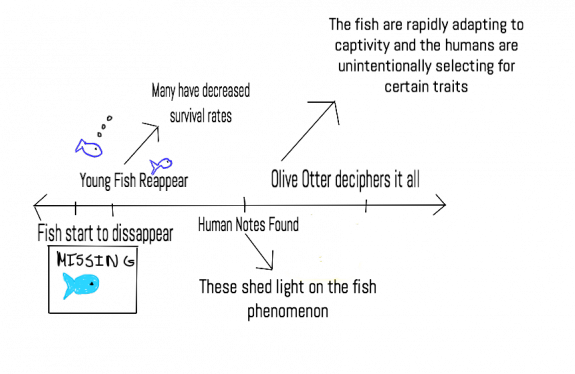
A Timeline of Events.
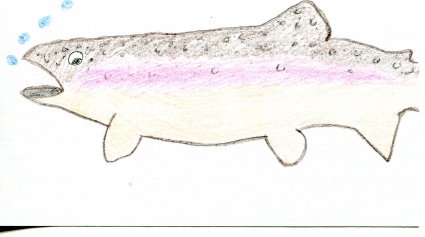
Sources:
Christie, Mark R., et al. “Genetic adaptation to captivity can occur in a single generation.”
Proceedings of the National Academy of Sciences of the United States of America 109.1
(2012): 238-242. Web. 15 March 2016.
Back Next
 Magazine Posts
Magazine Posts Table of Contents
Table of Contents